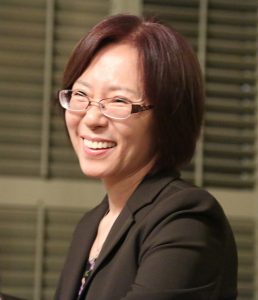Technology is everywhere. You see the ubiquitous iPad, smart phone, or tablet in the hands of the five year-old in his car seat, the 15-year-old texting friends and the 35 year-old keeping up with the office while vacationing. In an innovative project, professor Namkee Choi is taking advantage of the widespread availability of technology to bring needed mental health services to homebound older adults.

Long before Choi joined the faculty at The University of Texas at Austin, she volunteered for Meals on Wheels, a federally funded program that delivers hot meals to homebound seniors. Her volunteer work with this program dates back to 1994 and continues to influence the research she does today as the School of Social Work’s Louis and Ann Wolens Centennial Chair in Gerontology.
Choi’s volunteer work involved delivering meals as well as doing grocery shopping for seniors, a task she preferred because it gave her more time to sit and talk with her clients.
The idea for what would become her tele-psychotherapy project came from one of those conversations, during which Choi realized that she was delivering much more than a hot meal or groceries.
Understanding the Needs of Homebound Seniors
“Volunteering for Meals on Wheels really opened my eyes about the level of depression and social isolation that these older adults are experiencing,” Choi recalls. “The stories I heard were heart-breaking.”
Studies Choi has conducted supported what she saw first-hand as a volunteer: medically ill, homebound older adults are more vulnerable to depression than their mobility unimpaired peers. Isolation and multiple stressors, Choi explained, can contribute to the problem.
“When I say isolation, I mean they are isolated from meaningful social engagement or social activities, even if there are a lot of people coming to their house, such as home healthcare workers, other service providers, informal caregivers or helpers. Older adults depend on other people for so many things, but it can be very stressful to have all these helpers in your home all the time.
“Older adults really need great coping skills for their multiple life stressors. For low-income older adults, there is also financial stress. Daily self-care activities and keeping up with medical appointments for their chronic illnesses require lots of time and energy. Some also have family issues and strained relationships,” Choi explained.

Studies indicate that older adults who take multiple medications for their conditions prefer talk therapy to antidepressant medications. However, there is a stigma and discomfort attached to seeking psychotherapy.
“One of my first grocery-shopping clients in Austin, an 86-year old woman, kept telling me, ‘I am so depressed.’ But she was reluctant to go to any clinic-based therapy because she didn’t want to be seen doing so. In any case, she could not drive and could not afford other transportation, so she really had no way of getting to a therapy session,” Choi reflected.
Options that involve either transporting homebound older adults to clinics or the clinicians to homebound older adults’ homes are costly, and in-home psychotherapy programs are not widely available in most communities.
“There are some Internet-based, self-guided depression interventions or support groups that people can do on their own. However, low-income homebound older adults seldom access those because many of them do not have the Internet connection or sufficient Internet operational skills,” Choi said. “Most previous tele-mental health services were clinic-based and the patient still had to go to a clinic to see a psychologist or a psychiatrist who was located offsite.”
When Choi started thinking about how to help depressed homebound older adults, she was really keen on bringing the tele-health technologies into the home.
“We have this wonderful technology,” she said. “We could easily bring it into their houses, and they would be able to participate in treatment in the privacy and comfort of their own home.”
Choi applied for a grant from the National Institute of Mental Health (NIMH), and in 2009, she was awarded a $680,000 grant for a 3-year project. The purpose of the grant was to test the feasibility and efficacy of tele-health Problem-Solving Therapy (tele-PST), compared to in-person PST and telephone support calls for depressed, low-income homebound older adults. This was the first study that evaluated delivery of PST via an in-home videoconferencing method.
In addition to NIMH funds, Choi received funding from the St. David’s Foundation and the Roy F. and Joann Cole Mitte Foundation that allowed her to include more clients in the study.
The Therapist can Skype You In!
The technology Choi had in mind for tele-PST sessions was quite simple and easy to use. Participants were loaned laptop computers with freely accessible Skype video call installed and prepaid USB 3G wireless cards. They were also provided with a headset so their conversation could be more private. Sessions began with the therapist making a phone call to the participant to ask him or her to turn on the computer, so that the tele-PST session could start.
When six tele-PST sessions were completed, the laptop computers were moved to the next group of participants. Costs for the equipment and wireless service were covered under the NIMH grant.
Problem-Solving Therapy (PST), the intervention that Choi selected, is evidence-based and well-suited to low-income homebound older adults with multiple life stressors. PST, originally developed in England in the 1980’s,is grounded in the cognitive-behavioral theory of mental health. PST stems from the theory that people with deficits in problem-solving skills become vulnerable to depression because such deficits lead to ineffective coping attempts under high levels of stress.
During the 1990s, PST was adapted for delivery in fast paced primary care settings, where it could be delivered in four to six sessions of 30-60 minutes each. Choi’s collaborator, Mark T. Hegel from the Giesel School of Medicine at Dartmouth, is one of the first proponents of using PST in primary care settings, and developed training programs for its use in the United States. Hegel trained the two graduates from the School of Social Work who conducted the PST sessions for Choi’s project.
Participants for the study were recruited through referrals from case managers of Meals on Wheels and from four other aging-service agencies serving low-income, disabled older adults in central Texas. The main inclusion criteria were that they be homebound with moderately severe and severe depressive symptoms. Those with a high suicide risk, dementia, bipolar disorder, and/or presence of co-occurring alcohol or other substance abuse were excluded from the study, because PST has no or limited evidence base for these conditions.
Wellness at Home
Getting seniors to seek help for their depression first meant overcoming their sense of stigma related to mental illness. The program was referred to as “wellness at home.” Choi also tried to overcome the stigma of depression in her conversations with prospective participants.
“I am a proponent of saying it out loud,” she said. “Depression is no different than any chronic disease … and it’s treatable! I did telephone screening for most prospective participants, and I would say, ‘Name one person that you know who didn’t have any depression in life.’ And the clients appreciated that. This is part of life in this earth so you don’t have anything to be ashamed about.”
During her calls, Choi saw that the use of technology could be a barrier. When the study was described to potential participants, being part of the tele-PST group was not first choice for many.
“I would tell them that they would be assigned to one of these three interventions: Tele-PST, in-person PST, or telephone support. And most of the people told me they hoped they got the in-person PST.’”
Choi said that about half of those assigned to tele-PST had initial resistance to the technology, but that changed pretty quickly and almost all of tele-PST participants loved tele-delivery.
The study had a total of 214 participants, ranging in age from 50 to over 80. The 50-64 age group was included because Choi’s previous study found that a higher proportion of this younger group of homebound adults than those 65 and older suffered from depression and lack of health insurance.
The study ran for 36 weeks for each participant, with follow-up assessments administered at 12, 24, and 36 weeks. A modified Treatment Evaluation Inventory (TEI) was used to compare acceptability of tele-PST to that of in-person PST. The TEI scale measured items such as acceptability of the treatment, likeability of the procedures used, and negative aspects, such as any side effects or discomfort with the type of treatment.
Findings showed that both groups liked PST itself, with the tele-PST group reporting slightly higher TEI scores than the in-person PST group. The difference in TEI scores was statistically significant.
“First of all, they really liked the convenience of tele-PST,” said Choi. “They said, ‘Oh I don’t feel guilty about not cleaning my house. I can do it in my pajamas and I can still see the therapist as if she’s sitting right next to me.’”
The tele-delivery also addressed privacy issues.
“They said tele-PST was much better than going to a clinic where a lot of people may see them come in for services,” said Choi.
The “Cool” Factor
Still the biggest bonus of tele-PST was the technology itself, or what Choi calls the “cool” factor. Comments from study participants showed that they loved using the computer and the video conferencing system.
Results also showed a significant reduction in depression symptoms. Choi found great courage in the words of the participants’ themselves.
“I was just so awed by feedback from these older adults,” Choi explained, still marveling at the impact of the study. “About 90 percent of them said that it was a life changing experience for them. Some people cried as they talked about how much they’ve changed and how PST helped them get out of depression.”
The university-community link was also strengthened by the project as the participant feedback reached case managers and service providers at the agencies through which recruitment was done.
“Some service providers were initially hesitant when I approached them about collaborating with the university on this project,” Choi explained. “But they’ve changed. Their clients were saying to their case managers, ‘You remember you talked to me about doing that research project and you don’t know how it changed my life.’”
“All case managers who referred their clients to the study said hearing that from the clients was the turning point, and they want to see the project continue. So we have the buy-in of the clients and the social service providers and that’s exciting as we look to our next project.”
The fact that the project provided services in the process of conducting research was a plus.
“Dr. Roberto Rodriguez from the St. David’s Foundation told us that they don’t usually fund research projects,” Choi remembered. “But he said that the tele-PST project married the research with the service so that it had an immediate positive impact in older adults’ lives.”
Next Steps
Choi’s next step is a logical one. Since the tele-PST service has its roots in her work in the community, she is looking for funding that can help more aging agencies make this service available to their clients. Choi is planning to apply for funding to embed tele-PST therapists in aging-service agencies for increased effectiveness, efficiency, and acceptability. That approach can make a major difference on how many people can be exposed to and thus benefit from tele-PST.
“It would be much more effective and efficient,” said Choi. “Effective because the PST therapist will work directly with the case managers who know a lot more about the individual clients. We can even shorten the time to five rather than six sessions, because they’d have the case manager assessment as a starting point.
“It would be more acceptable to older adults, because they tend to trust their aging-service providers, and we’ll have more success in terms of the recruitment and the retention of participants,” Choi concluded.
Just as Dr. Choi found a match between her volunteer service and her research interests, the two graduates from the School of Social Work who worked on the tele-PST project find themselves drawn to working with older adults.
Leslie Sirrianni and Mary Lynn Marinucci had just received their master’s degree when Choi hired them for the project. They both are now able to conduct the PST training themselves, and are looking forward to being part of other projects working with older adults.
As Choi plans for another round of bringing services to people through technology, one can’t help but wonder if she still volunteers for Meals on Wheels.
Choi laughs as she responds. “I only stopped working directly with older adults delivering meals or helping them with grocery shopping last summer because I had to write this big grant.”
It doesn’t matter that she isn’t knocking on the doors of seniors any more. Choi’s work has brought life-changing services to them, with the simple touch of a button, and a lot of passion for making technology be part of the solution.
– By Karen Kalergis
